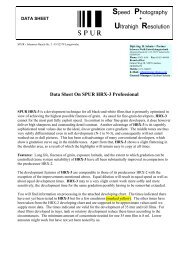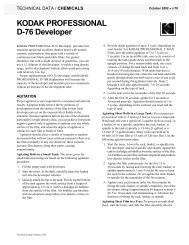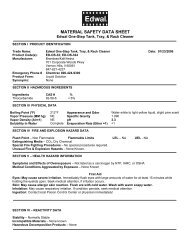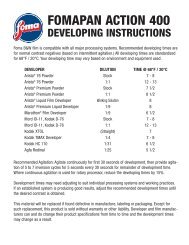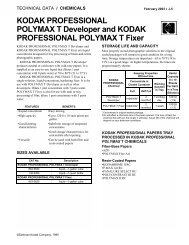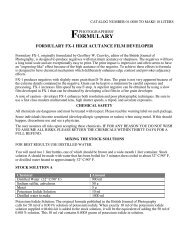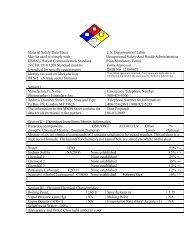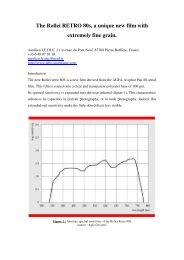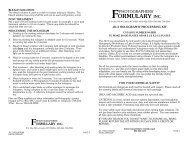KODAK PROFESSIONAL XTOL Developer
KODAK PROFESSIONAL XTOL Developer
KODAK PROFESSIONAL XTOL Developer
Create successful ePaper yourself
Turn your PDF publications into a flip-book with our unique Google optimized e-Paper software.
System Maintenance<br />
<strong>KODAK</strong> <strong>PROFESSIONAL</strong> <strong>XTOL</strong> <strong>Developer</strong> is very<br />
clean-working, and will rarely need replacement in a<br />
properly replenished and maintained process.<br />
Take these steps for routine maintenance:<br />
• Minimize air access to the replenisher tanks. Use<br />
floating lids.<br />
• Use a small amount of water to rinse the developer<br />
from processor parts left exposed to air after<br />
shutdown.<br />
• Replace evaporation losses with water at processor<br />
start-up.<br />
• If your processor is equipped with recirculation filters,<br />
check them frequently, and change them as needed.<br />
Disposal<br />
Dispose of used developer in accordance with your local<br />
regulations. Refer to the Material Safety Data Sheets for<br />
more information.<br />
If you have environmental or safety questions about<br />
Kodak products or services, contact Kodak Environmental<br />
Services at 716-477-3194, between 8 a.m. and 5 p.m.<br />
(Eastern time).<br />
Kodak also maintains a 24-hour health hotline to answer<br />
questions about the safe handling of photographic<br />
chemicals. If you need health-related information about<br />
Kodak products, call 1-716-722-5151.<br />
Development Tables<br />
The following pages contain tables of starting-point development times and temperatures for developer solutions with and<br />
without dilution in small tanks, trays, rotary tubes, and large-tank replenished systems. This information includes processing<br />
data for Kodak films as well as for a sampling of other manufacturers’ films. For critical applications, run tests to determine the<br />
best development time. Data for nominal film speeds are in bold face type.<br />
Table No.<br />
Roll Films:<br />
Title Page<br />
1 Processing Roll Film in Small Tanks 6<br />
2 Processing Roll Film in Rotary Tubes 8<br />
3 Processing Roll Film in Large Tanks with Seasoned (Replenished) <strong>Developer</strong> 11<br />
4<br />
Sheet Films:<br />
Processing Roll Film in Large Tanks with Fresh <strong>Developer</strong> 13<br />
5 Processing Sheet Film in Trays 14<br />
6 Processing Sheet Film in Rotary Tubes 14<br />
7 Processing Sheet Film in Large Tanks with Seasoned (Replenished) <strong>Developer</strong> 15<br />
8 Processing Sheet Film Large Tanks with Fresh <strong>Developer</strong> 15<br />
<strong>KODAK</strong> <strong>PROFESSIONAL</strong> <strong>XTOL</strong> <strong>Developer</strong> • J-109 5



